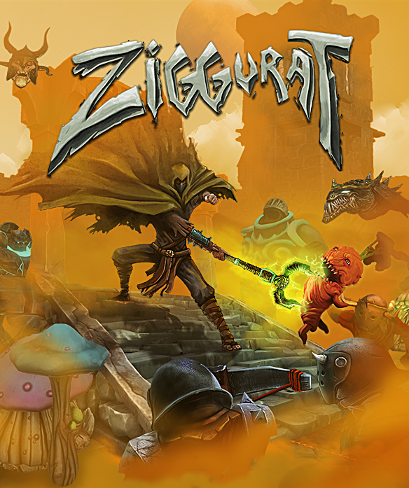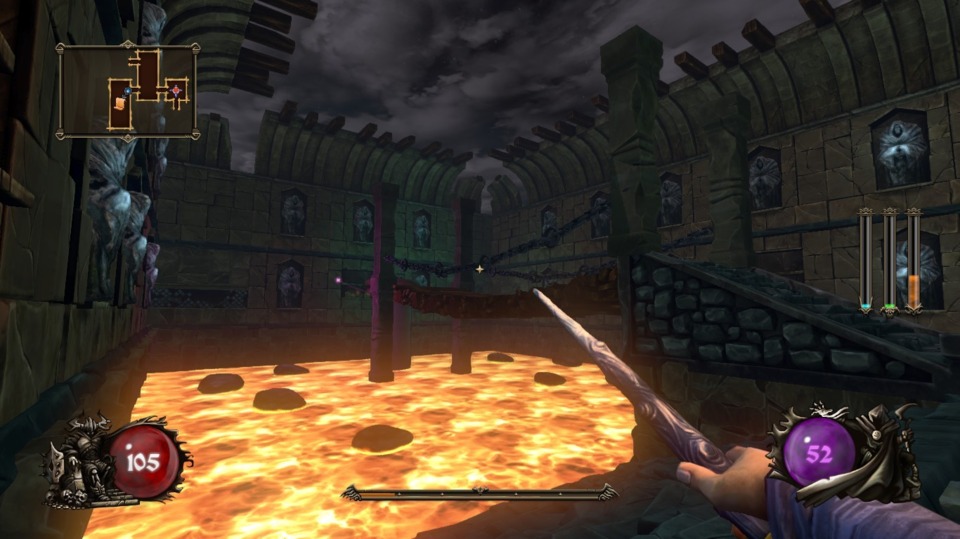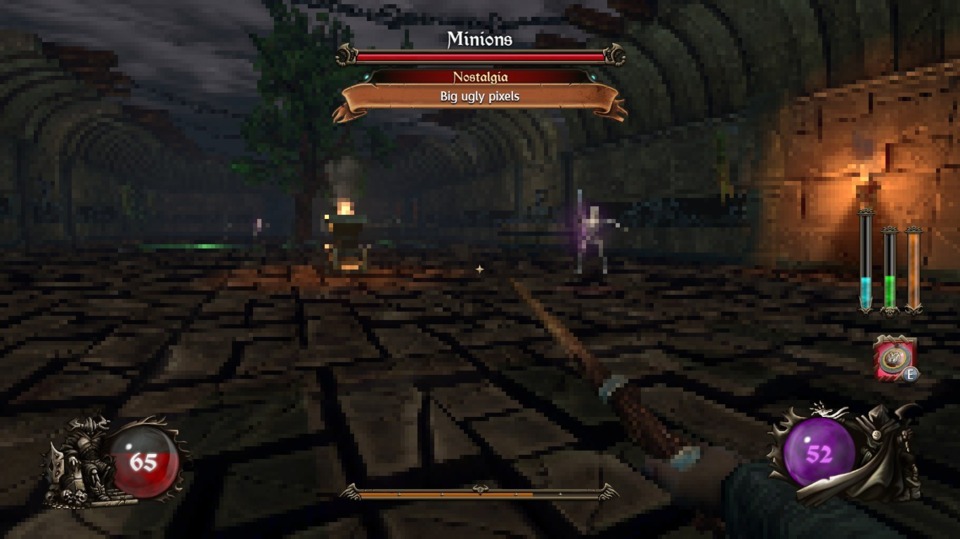Indie Game of the Week 24: Ziggurat
By Mento 7 Comments

I realize I'm late to the party on this one. Ziggurat is essentially a roguelike Hexen, right down to the slow-moving fireballs and ominous cloaked protagonist, with the player moving through a procedurally-generated dungeon in first-person while fighting off waves of enemies and recovering various useful relics and spells before facing off with the floor's boss and moving on to the next. The game's cadence, since that was E3's big word this year, is similar to that of Spelunky or The Binding of Isaac: while there are unlockables you can earn post-run to "enhance" subsequent playthroughs, at least in a manner of speaking, any true progress has to come from the player themselves. If they're getting killed frequently on the first two floors, which I most certainly am, it's down to them to get better at the game, learn how to effectively fight specific monsters and bosses, figure out which weapons work best for them, and then hope for but not rely on a smidgen of luck when it comes to the game's many random elements, between the types of enemies the player might face or the selection of perks they're offered upon levelling up. The randomness serves to remind the player that they shouldn't be discouraged if they happen to crash and burn far sooner than their best runs: chances are, they just got unlucky one too many times.
The average run of Ziggurat begins as follows: you pick a character from a default male and female option, with others to be unlocked after certain milestones are met, and you start with nothing but your peashooter wand, which is the only weapon in your arsenal that doesn't need ammo pick-ups (though it does have a cooldown of sorts if you overuse it), and find other weapons while playing. There are three types of these weapons, each using their own color-coded ammo type, and the number of weapons that might become accessible to you increases as you play the game. As you level up after defeating monsters and collecting the gems they leave behind, you get given two perks to choose from. Some of these perks are passive, like increasing the XP you earn or recovering health from destroying objects in the environment, while the rest are one-off boons that either work then and there or are stored in your inventory for when you need it. There's some long-term vs short-term planning involved here: a one-off health refill might be seen as a waste of a level-up perk, but not when you're low on HP and there's a boss coming up. An XP booster or a perk that gives you bonus health before an encounter might be useful in the long run, but if you're unlikely to survive the next boss fight, what's the point?

Much like how Rogue Legacy or Spelunky is a variation of a roguelike (or "roguelite", if you'd prefer) that challenges the player's 2D platforming skills instead of the tactical turn-based RPG exploration of Rogue itself, or The Binding of Isaac with dual-stick shooters, Ziggurat attempts to leverage the player's FPS experience to make its gameplay tick. While the player can use all the tactics and lucky breaks they're afforded by the roguelike component, it ultimately comes down to how well they can strafe around a room keeping a horde of vicious creatures at bay in the manner of FPS games of old. The monsters range from your Serious Sam-style mindless chargers to corral around a room to those that adopt the same shoot and weave tactics that you do: skeletons plant themselves in range and spam you with swords, banshees get close for their shotgun blast-like screams to be effective, and imps fly out of reach dropping tri-directional waves of fire in your direction to keep your lateral evasive options limited. What would normally be one of the weakest enemies, the kobolds, use a ranged attack that can actually predict your movement, leading their shots to hit you as you instinctively strafe around them. While I've never been a big fan of the "summoned waves" approach to combat in a game like this, where a room slowly fills up with enemies spawning from all directions until it eventually hits a designated limit, the enemies themselves vary enough in their countenance and tactics alike that it can make every encounter feel distinct. Given that Ziggurat's learning curve is so dependent on player experience rather than unlockables, creating a system where the game slowly gets easier as you learn what to expect from certain enemy types and which perks to aim for is an effective means of bolstering that curve.
I was also pleasantly surprised to find out that, because Ziggurat has this impressionistic but not particularly detailed look, it makes the game very palatable to the limited tech of this laptop. The lion's share of its graphical presentation is in effects and lighting, the kind of things you can dial down without much detriment to the game's visuals, and the environments and monsters have a cartoonish simplicity to them that still works aesthetically but doesn't tax the ol' processors. Due to circumstances, I've always been a fan of a game that "has a look", to borrow the parlance of one Austin Walker, without necessarily requiring a huge budget to produce and a comparatively costly rig to run it. Best of all, I didn't get the framerate slowdown I might have anticipated with an FPS game that frequently drops large numbers of foes on you, which would be hugely detrimental to a game of this type.

Right now, as I'm writing up my thoughts on Ziggurat, I'm wondering what kind of impression it has left on me in a subconscious sense. When I shut the game down and started typing earlier today, I was happy to see the end of it. It's not particularly frustrating, but dying constantly after making little progress suggests to me that I'd need a lot more time to get a grip on the game's foibles and maybe unlock a few new characters or perks before I would start to see any major progress. After some time away, however, I'm actually eager to try it again, to see if I can get a little further or work towards those unlocks and to see if it the meta progress I'm making will actually help subsequent runs. It feels like I'm slowly getting better at dealing with these mobs also, though the game's handful of platforming challenges are still beyond me (I don't know what it is about platforming in first-person, but it seems like it's very difficult to make it feel natural). I might not be done with Ziggurat quite yet, then.
Rating: 4 out of 5.
| < Back to 23: Rebel Galaxy | > Forward to 25: Lara Croft Go |
